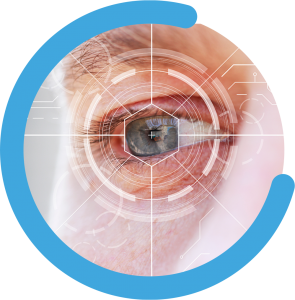Cataracts
Cataracts are extremely common. In fact, the majority of those over 65 have some cataract development. If you have been told you have cataracts, DO NOT be alarmed.
The word “cataract” comes from the Greek word “Cataracti”, which means waterfall. The lens can appear to look a bit like a waterfall when the cataract is quite advanced.

What is a cataract?
A cataract simply refers to ‘opacity of the lens’ inside the eye. Looking through a cataract can be thought of as a little bit like looking through an old stained piece of glass – instead of a clear new sheet.
There are many different types of cataract. Not all cataracts cause symptoms. If a cataract causes no symptoms, it can usually be left alone. If symptoms such as blurred vision occur, then cataracts can be treated very successfully with surgery.
The eye is filled primarily with water based substances and liquids. Think of there being a ‘tap’ inside the eye – constantly producing fresh liquid. This ‘tap’ is a layer of cells behind the iris (the coloured part of the eye). The fluid produced is called ‘aqueous’. This liquid is inside the eye, and is not connected to the tears.
The eye also has a ‘drainage’ system. The drains are located at the front of the eye, between the edge of the cornea and the iris.
So, increased pressure in the eye is due to increased production of fluid, or decreased drainage of fluid from the eye (or a combination of both).
The mechanism of damage is unclear. Certainly, when the pressure goes up very suddenly (as in acute glaucoma), there is clearly a lack of blood supply to the nerve head in the eye. There are various other theories as to how the nerve damage actually occurs.
What is certainly known, is that LOWERING this pressure delays the progression of glaucoma. In sudden acute glaucoma, lowering the pressure can save the sight in an eye which is otherwise destined to lose vision.
It is one of the commonest reasons for blindness in the Western world. There are several different types. These include chronic simple glaucoma (the commonest type), acute glaucoma, congential glaucoma and secondary glaucomas which arise secondary to some other condition or influence.
There are several ‘risk factors’ for developng chronic glaucoma. These are:
- Age – Chronic glaucoma is uncommon below the age of 40, but affects 1% of people over this age and 5% over 65.
- Race – People of Afro-carribean origin have an increased risk of developing glaucoma.
- Family History – There is a ‘genetic’ element to glaucoma. If a close relative (parent/sibling) has Glaucoma, you should not worry, but ensure you have regular check ups to detect any changes as early as possible, should they ever occur.
- Myopia – Very short sighted people are more at risk of developng chronic glaucoma
The cataract operation
Cataract surgery is one of the most common and quickest surgeries performed today. Modern cataract surgery (called phacoemulsification) is usually performed under local anaesthetic as a day case procedure. During the surgery, a tiny incision is made into the eye and the lens removed with an ultra-sound probe. The capsule of the lens is left behind and this is used to house the new lens implant. The whole procedure takes between 15 and 20 minutes, and the visual recovery is very quick with most patients noticing improved vision within a matter of days.

Lens implant types
Each patient and each eye is different. Measurements are taken prior to surgery (called biometry) to establish the correct lens power for the individual eye. Lens implants also come in different types. The two major categories of lens implant are:
Monofocal lenses
(the vast majority of patients have this lens type put in). These provide good distance vision but glasses are required for close work.
Multifocal lenses
These lenses offer a high probability of achieving spectacle independence i.e. providing patients with the ability to see far as well as to read without glasses
Multifocal lenses have been shown to offer a high chance of reducing dependence on glasses for near and middle distance vision. However, patients can experience a reduction in contrast sensitivity (especially in dim lighting), as well as halos and glare around lights at night. Some patients are prepared to accept these visual effects because they are very keen to reduce their reliance on glasses.
The pre-operative preparations for patients interested in multifocal lens implants are more involved than when monofocal lenses are being used, a wider range of issues needs to be discussed and the post-operative management is more intensive. These are the major reasons that these lenses are not offered on the NHS.
Get in touch
Please contact us if you have any queries or questions about our eye examination and related issues, we would be most happy to advise you.
